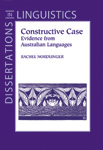

|
|
|
|

Constructive CaseEvidence From Australian Languages Australian Aboriginal languages have many interesting grammatical characteristics that challenge some of the central assumptions of current linguistic theory. These languages exhibit many unusual morphosyntactic characteristics that have not yet been adequately incorporated into current linguistic theory. This volume focuses on the complex properties of case morphology in these nonconfigurational languages, including extensive case stacking and the use of case to mark tense/aspect/mood. While problematic for many syntactic approaches, these case properties are given a natural and unified account in the lexicalist model of constructive case developed in this book, which allows case morphology to construct the larger syntactic context independently of phrase structure. was a postdoctoral fellow at the Max Planck Institute for Psycholinguistics in Nijmegen, The Netherlands, at the time of this publication. Contents
3/1/98 ISBN (Paperback): 1575861348 (9781575861340)
Subject: Linguistics; Australian Languages--Case; Australian Languages--Syntax |
Distributed by the
University of Chicago Press |
|
pubs @ csli.stanford.edu
|
CSLI Publications
Stanford University Cordura Hall 210 Panama Street Stanford, CA 94305-4101 (650) 723-1839 |